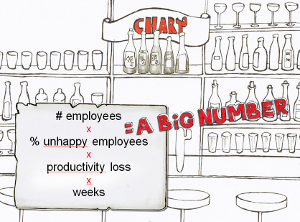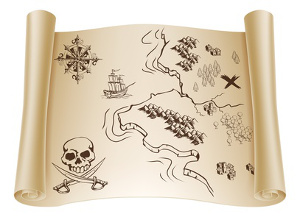The benefits of Gamification explained in a playful way
Did you know?

The age of the average gamer is 37.

Men and women equally enjoy gaming.

Most gamers are socializers.
What can we do to use this potential?
This is where Gamification comes into play. The formal definition of Gamification is:

Phillip Herzig, SAP Gamification Trainer Lead, describes Gamification as a
new method of thinking of how to develop and design business applications.
But Gamification is not just about fun, it is also about business and money.
How so?
The problem in lots of companies:

According to Bart Briers, Managing Director for CTG Europe and Professor at
the EHSAL Management School in Brussels, the average number of people that are
unhappy in a company is 47 %, this results in a 47% loss in productivity: On
average companies lose $75 per unhappy employer/week. You can do the math.
What makes people happy? Good relationships and job satisfaction. So
companies have to create a good atmosphere and interactive work environment:
this is where Gamification comes into play.
The purpose of Gamification is to

Gamification is about feedback, progression, design, competition, teams,
entertainment, success, learning, motivation, games, education and curiosity. As
Mario Herger, CEO Enterprise Gamification Consultancy LLC, says, “when we
empathize with people and look at what they are motivated and interested in and
give them playful experiences, it is for the benefit of the players, and for the
benefit of everyone else: companies, customers and co-workers.”
Gamification creates a lot of data that can help you in your career. Not only
are you rewarded for your work, you can also clearly see what you have
accomplished, follow your progress, know what you have done and how well you
have done it. A competency profile is basically built automatically.

Like Herger suggests, if you use design elements such as fantasy, themes or
narrative, a boring, everyday task can become interesting. For example because
we are playing for the souls of pirates: each costumer ticket we close brings
our pirate ship closer to the treasure island (where we can have a pirate
party).

Annie the orphan is a metaphor for Gamification: working hard and having fun at
the same time.
Examples for Gamification

g-learning
G-learning, from SAP, is an interactive experience for mobile app developers.
It uses Gamification to offer practical knowledge and training in a more
interactive way and game-like environment. In an eight week program, players
from all over the world work together to learn and develop new skills. They
visit virtual cities in a global environment and interact socially via chat and
a JAM collaboration tool. They face challenges together and collect badges, gain
social skills and complete missions along the way.
Isa Sammet, SAP Gamification Education Lead, says that g-learning is so
successful because it rewards teams more than individuals. In this way, team
members motivate the others to stay focused and return to g-learning every day.
If you make employees happy while learning, they will retain the knowledge much
longer. “For SAP this way of learning, having fun and being challenged while
learning, is what helps to retain knowledge: every individual can learn
according to his or her needs and has the autonomy to decide on following our
suggestion or just go according to their own pace.”
Gamification Days at SAP

The first “Gamification Days” in Walldorf last week offered employees at SAP an
opportunity to understand and embrace the concepts of Gamification thinking and
design. The event included inspirational talks by Gamification Gurus Mario
Herger, CEO, founder and partner of Enterprise Gamification Consultancy LLC (you
can watch his talk here), and Bart Briers, Managing Director for CTG Europe and
Professor at the EHSAL Management School in Brussels, and workshops for
Gamification Design and Gamification Platform as well as consulting hours with
trainers on how to make the first steps towards implementing Gamification.
